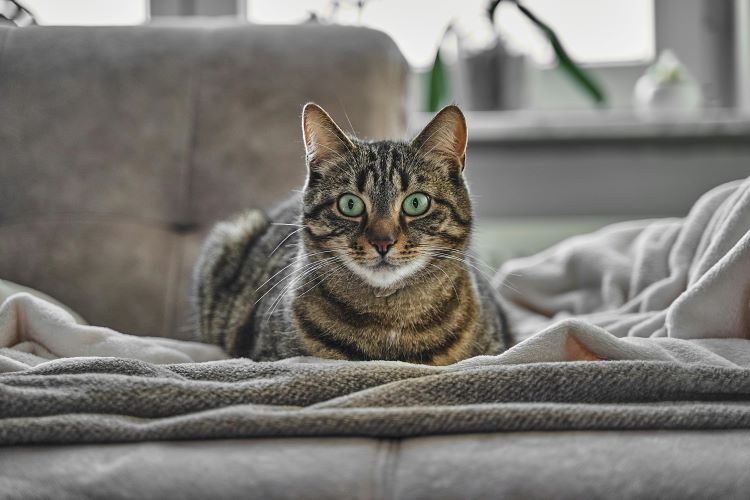Ready to help treat your pet to a healthy life?
Does Pet Aromatherapy Work (and Does Pet Insurance Cover it)?
By : Brianna Gunter | Published Feb 25, 2025

Humans and animals alike are drawn to certain scents. So, perhaps it’s no surprise that aromatherapy for dogs and cats has grown in prevalence just as it has for humans. But while we all enjoy things that smell good, does aromatherapy for your pet actually work in terms of improving health and well-being?
Proponents of pet aromatherapy maintain that it helps calm and prevent stress in pets, among other benefits. However, aromatherapy for dogs and cats may not be as effective as it seems. And before you go firing up that aromatic oil diffuser, it’s important to note upfront that some types of essential oils are actually harmful to our furry friends.
In order to help you make the best decision for your pet (and have realistic expectations), here’s important information about the efficacy of pet aromatherapy, safety tips, and potential risks.
What is aromatherapy for pets?
Pet aromatherapy is the use of essential oils to promote physical and emotional well-being in dogs, cats, and occasionally other companion animals. For the unfamiliar, essential oils are naturally occurring compounds that come from plants. They are highly aromatic, and usually just a few drops are required due to the potency.
Common essential oils used for pet aromatherapy are lavender, frankincense, chamomile, rosemary and cedarwood, though occasionally others may be used. Always check in with your veterinarian first though, and be aware that some oils considered safe for dogs may not be safe for cats. When used safely, however, proponents believe pet aromatherapy may provide numerous benefits:
- Calming and anti-stress
- Supporting immune health
- Easing pain
- Soothing skin and fur problems
- Parasite repellant
According to Trupanion veterinarian Dr. Sarah Nold, however, it’s important to be skeptical of these purported benefits.
“We still don’t have much clinical evidence that aromatherapy is beneficial to animals,” Nold says. “I think the strongest support is for the use of lavender, chamomile, and sandalwood scents to reduce anxiety and have a positive effect on behavior and mood.”
How it works
Pets — especially dogs — have extremely strong senses of smell, and essential oils are naturally potent. Just small doses are necessary for the purported therapeutic effects. While the oils themselves may have some topical benefits, the focus here is on the scents. There are a few different ways to bring these aromatics to your pet’s senses:
- Diffusion — Using a pet-safe essential oil diffuser to disperse oils into the air.
- Sprays — Oils can be partially diluted in water or a carrier substance in a spray bottle or timed spray device, releasing the scents into the air or onto a pet’s favorite items.
- Topical application — Diluted essential oils can be applied to a pet’s skin or fur, though this should be done with caution and under professional guidance. Aromatic oils may also be applied via massage for the pet.
Aromatherapy for cats and dogs is often done by pet owners at home, but some veterinary practices may offer it onsite. In any case, always talk with your pet’s veterinarian ahead of time before trying any new treatment. It’s also worth noting that some essential oils are highly toxic to pets, so always get professional approval for the specific type you wish to use. Essential oils for pets are also not the same as pet perfumes, though both carry risks.

Is it effective? What the science says
So, the big question — does pet aromatherapy actually work? Much of the existing evidence for aromatherapy working on pets is anecdotal. As of 2025, research has been limited. One study back in 2006 found that exposure to the “ambient odor of lavender” resulted in dogs spending more time resting and sitting quietly in their owners’ cars instead of moving around and vocalizing.
A more recent study in 2020 examined the use of essential oils by veterinarians to combat bacterial and fungal infections in pets. The researchers found essential oils to be effective for both environment disinfection and helping to prevent infection spread when topically applied to animals, but emphasized that close attention was required at all times to prevent adverse effects.
Some pet owners may find that to be sufficient evidence, but the fact is that more research is needed to know for sure. Studies of essential oil use for humans have meanwhile been mixed. For example, a team of Johns Hopkins researchers found certain types of oils to be effective against harmful bacteria by themselves, but the effects could not be reliably replicated when human subjects were involved.
Additionally, not all essential oil brands may be equally safe or effective.
“There are poor controls on the essential oil industry,” Nold says. “So, if your veterinarian recommends a specific, trusted brand, it is safest to only use that specific brand.”
More safety concerns and risks
Whether or not essential oils have any positive effects on your pet’s health and well-being, they can be dangerous if the proper precautions are not followed. As mentioned, certain kinds of essential oils are highly toxic to dogs and/or cats. Your pet can also experience internal irritation and inflammation just from breathing harmful oils in.
7 tips for safe aromatherapy for dogs and cats
Even if you’ve practiced pet aromatherapy before without issue, check this list to make sure you’re staying safe.
1. Avoid unsafe essential oils
Many essential oils that are popular for human aromatherapy are toxic to pets and should be avoided. These include:
- Peppermint oil
- Citrus oil (primarily lemon but all citrus oils should be avoided)
- Pennyroyal oil
- Cinnamon oil
- Sweet birch oil
- Yarrow root oil
- Tea tree oil
And while lavender is generally considered safe for pets, it’s still important to take caution. According to Nold, excessive or chronic use of lavender may promote the development of allergies in dogs and cats.
Some pets may have additional sensitivities. Talk with your veterinarian about what may work best for your pal, and avoid pet aromatherapy if your pet has had any bad reactions to essential oils in the past.
2. Dilute, dilute, dilute!
Essential oils should always be heavily diluted before use, whether in a diffuser or for topical application. Never apply undiluted oils directly to your pet’s skin or fur. Doing so can cause extreme skin irritation. In fact, you’ll want to check with your vet first before applying any oils topically.
As Nold says, “I would avoid recommending topical application, with the exception of if a veterinarian specifically recommends doing so and even then proceed with caution, just because of heightened safety concerns with this method.”
3. Provide an aromatherapy-free zone
Not all pets may enjoy aromatherapy, and some may downright dislike it. So, if you choose to use aromatherapy in your home, Nold strongly advises having a free zone (or escape route) so your pet can distance themself from the scent if desired.
“Remember, [pets] have a much more sensitive sense of smell then we do,” Nold says. “Keep in mind that with pets with mobility concerns or confinement they may not be able to move away even if it is bothering them.”
4. Prevent ingestion
Always store oils in containers pets can’t open, in places they cannot reach. Never leave pets unattended with essential oils, an oil diffuser, or any aromatherapy product. If your veterinarian gives you approval to apply oils topically, only do so in non-sensitive places where your pet cannot easily lick.
The risks aren’t just limited to essential oils. Learn more about preventing pet poisoning at home.
5. Monitor your pet closely
No matter how you choose to administer aromatherapy, watch your pet closely both during and after. Stop immediately and call your closest emergency animal hospital if they show any adverse reactions like drooling, vomiting, difficulty breathing, or unusual changes in behavior.
6. Avoid essential oils with respiratory conditions
There is growing evidence that essential oils emit volatile organic compounds (VOCs), which can cause damage to the respiratory tract in humans and pets alike. The essential oil industry is unregulated, and again, more research on this is needed to know the full impact. However, it’s best to avoid essential oil aromatherapy entirely if you, your pet, or another member of your household has a respiratory condition.
7. Know when to talk with your veterinarian
As with all new pet treatments, whether they’re holistic or more traditional, it’s important to not proceed without the go-ahead from your vet. It can’t be stressed enough that you should talk with your pet’s veterinarian before starting any aromatherapy regimen — don’t be afraid to ask about different kinds of oils. And of course, get your pet immediate medical attention if they start showing any adverse reactions.

Does pet insurance cover aromatherapy?
A few pet insurance providers may cover aromatherapy, but many do not due to it not being regulated or a standard part of pet medical care. So, if you have coverage, it’s important to read the details of your plan closely. At Trupanion, for example, aromatherapy is not eligible for coverage because it is not a proven form of therapy for dogs and cats. To ensure pets are getting the best care for their conditions, only proven treatments with validation from veterinarians are eligible for coverage.
Whether you choose aromatherapy for your pet or not, pet insurance can still be a worthwhile investment for your pal’s health. Learn more today about the benefits pet medical insurance offers!
